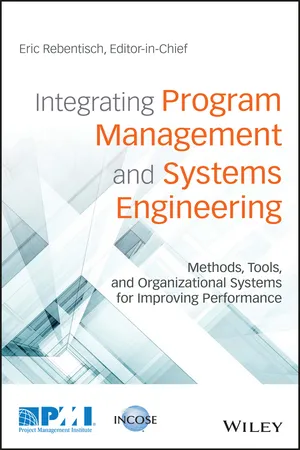
- English
- ePUB (mobile friendly)
- Available on iOS & Android
About this book
Integrate critical roles to improve overall performance in complex engineering projects
Integrating Program Management and Systems Engineering shows how organizations can become more effective, more efficient, and more responsive, and enjoy better performance outcomes. The discussion begins with an overview of key concepts, and details the challenges faced by System Engineering and Program Management practitioners every day. The practical framework that follows describes how the roles can be integrated successfully to streamline project workflow, with a catalog of tools for assessing and deploying best practices. Case studies detail how real-world companies have successfully implemented the framework to improve cost, schedule, and technical performance, and coverage of risk management throughout helps you ensure the success of your organization's own integration strategy. Available course outlines and PowerPoint slides bring this book directly into the academic or corporate classroom, and the discussion's practical emphasis provides a direct path to implementation.
The integration of management and technical work paves the way for smoother projects and more positive outcomes. This book describes the integrated goal, and provides a clear framework for successful transition.
- Overcome challenges and improve cost, schedule, and technical performance
- Assess current capabilities and build to the level your organization needs
- Manage risk throughout all stages of integration and performance improvement
- Deploy best practices for teams and systems using the most effective tools
Complex engineering systems are prone to budget slips, scheduling errors, and a variety of challenges that affect the final outcome. These challenges are a sign of failure on the part of both management and technical, but can be overcome by integrating the roles into a cohesive unit focused on delivering a high-value product. Integrating Program Management with Systems Engineering provides a practical route to better performance for your organization as a whole.
Frequently asked questions
- Essential is ideal for learners and professionals who enjoy exploring a wide range of subjects. Access the Essential Library with 800,000+ trusted titles and best-sellers across business, personal growth, and the humanities. Includes unlimited reading time and Standard Read Aloud voice.
- Complete: Perfect for advanced learners and researchers needing full, unrestricted access. Unlock 1.4M+ books across hundreds of subjects, including academic and specialized titles. The Complete Plan also includes advanced features like Premium Read Aloud and Research Assistant.
Please note we cannot support devices running on iOS 13 and Android 7 or earlier. Learn more about using the app.
Information
Part I
IN SEARCH OF INTEGRATED SOLUTIONS
1
TOWARD A NEW MINDSET
1.1 Striving for Perfection in Complex Work
1.2 Boldly Going Again Where People Have Gone Before
Table of contents
- Cover
- Title Page
- Copyright
- Dedication
- Editors
- Contributors
- Table of Contents
- List of Figures
- List of Tables
- Foreword: Practices, Knowledge, and Innovation
- Preface
- Acknowledgments
- Introduction
- PART I: IN SEARCH OF INTEGRATED SOLUTIONS
- PART II: BUILDING CAPABILITIES TO EFFECTIVELY EXECUTE ENGINEERING PROGRAMS
- PART III: DEVELOPING INTEGRATION COMPETENCIES IN YOUR ORGANIZATION
- PART IV: A CALL TO ACTION
- AFTERWORD: TOWARD AN INTEGRATED FUTURE
- GLOSSARY
- INDEX
- End User License Agreement